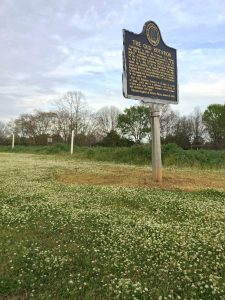Post contributed by Dr. Geoff Williams, Assistant Professor of Insect Pollination & Apiculture, College of Agriculture, Department of Entomology & Plant Pathology
Springtime in Alabama sees a flurry of activity by the state’s flora and fauna. Among one of the more prominent springtime activities is the buzzing of bees!
Big bees or small bees, native bees or introduced bees, now is the time when these insect pollinators really become evident. It’s not that they weren’t here before, it’s just that Spring is when many bee species emerge from their winter slumber to traverse the landscape in search of food, and maybe even places to nest.

Clover, currently in bloom at Auburn University’s ‘Old Rotation’, is an excellent source of both nectar and pollen for bees in the Spring.
Photo by G. Williams.
Bees have an intimate relationship with the landscape, in particular with many flowering plants. Flowers provide a source of carbohydrates for bees via their nectar, as well as proteins, minerals, lipids, and vitamins, via their pollen. Combined, these foods fuel and nourish bees with the dietary components that they need to properly develop and to perform necessary functions.
This is far from a one-sided affair, however. Plants benefit too! This is because many rely on bees, while they are out collecting their food, to transfer pollen from male to female flower parts. This process, called pollination, results in fertilization and eventual seed development. Well-known examples that rely on bees include many of the foods we eat, like cucumbers and watermelons. This is one reason why bees are so important. But for some of us, another reason might be the natural sweetener, called honey, produced by one well-known species!
While the introduced honey bee is often the most noticeable bee pollinator across Alabama and the country, a plethora of native species are also vital. A great example is the importance of a ground-nesting species, the Southeastern blueberry bee, to the Rabbiteye blueberries that we so love to eat.
As science advances and our knowledge grows, we have slowly started to understand not only the importance of bees to the environment, but also about how they are affected by us. No doubt, human changes to the landscape can positively, and negatively, affect bees. Unfortunately, in recent years we have observed higher than normal deaths of honey bee colonies, as well as population declines of many native bee species. The issue is extremely complex and highly charged; the current consensus is that a combination of parasites, poor habitat (think food and nesting), and environmental contamination, play an important role.
Here at Auburn my program will seek to improve our understanding of the bees of Alabama. This will primarily include identifying important factors affecting them, and developing sustainable solutions for promoting their well-being. Ultimately, this must be a team effort by all of us, and require striking a delicate balance among sustainably protecting bees, promoting the environment, and ensuring our food security.
To follow our progress, regularly check out Auburn University’s Insect Pollination & Apiculture website and Facebook pages!




